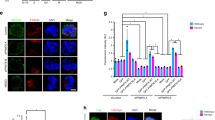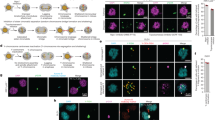Abstract
Certain chromosome rearrangements display a significant delay in chromosome replication timing (DRT) that is associated with a subsequent delay in mitotic chromosome condensation (DMC). DRT/DMC chromosomes are common in tumor cells in vitro and in vivo and occur frequently in cells exposed to ionizing radiation. A hallmark for these chromosomes is the delayed phosphorylation of serine 10 of histone H3 during mitosis. The chromosome passenger complex, consisting of multiple proteins including Aurora B kinase and INCENP is thought to be responsible for H3 phosphorylation, chromosome condensation and the subsequent segregation of chromosomes. In this report, we show that chromosomes with DRT/DMC contain phosphorylated Chk1, consistent with activation of the S–M phase checkpoint. Furthermore, we show that INCENP is recruited to the DRT/DMC chromosomes during all phases of mitosis. In contrast, Aurora B kinase is absent on DRT/DMC chromosomes when these chromosomes lack serine 10 phosphorylation of H3. We also show that mitotic arrest deficient 2 (Mad2), a member of the spindle assembly checkpoint, is present on DRT/DMC chromosomes at a time when the normally condensed chromosomes show no Mad2 staining, indicating that DRT/DMC activates the spindle assembly checkpoint. Finally, cells with DRT/DMC chromosomes have centrosome amplification, abnormal spindle assembly, endoreduplication and significant chromosome instability.
This is a preview of subscription content, access via your institution
Access options
Subscribe to this journal
Receive 50 print issues and online access
$259.00 per year
only $5.18 per issue
Buy this article
- Purchase on Springer Link
- Instant access to full article PDF
Prices may be subject to local taxes which are calculated during checkout







Similar content being viewed by others
References
Adams R, Carmena M, Earnshaw W . (2001). Chromosomal passengers and the (aurora) ABCs of mitosis. Trends Cell Biol 11: 49–54.
Andreassen P, Lohez O, Margolis R . (2003). G2 and spindle assembly checkpoint adaptation, and tetraploidy arrest: implications for intrinsic and chemically induced genomic instability. Mutat Res 532: 245–253.
Bartek J, Lukas C, Lukas J . (2004). Checking on DNA damage in S phase. Nat Rev Mol Cell Biol 5: 792–804.
Breger K, Smith L, Thayer M . (2005). Engineering translocations with delayed replication: evidence for cis control of chromosome replication timing. Hum Mol Genet 14: 2813–2827.
Breger K, Smith L, Turker M, Thayer M . (2004). Ionizing radiation induces frequent translocations with delayed replication and condensation. Cancer Res 64: 8231–8238.
Carmena M, Earnshaw W . (2003). The cellular geography of aurora kinases. Nat Rev Mol Cell Biol 4: 842–854.
Galgoczy D, Toczyski D . (2001). Checkpoint adaptation precedes spontaneous and damage-induced genomic instability in yeast. Mol Cell Biol 21: 1710–1718.
Hendzel M, Wei Y, Mancini M, Van Hooser A, Ranalli T, Brinkley B et al. (1997). Mitosis-specific phosphorylation of histone H3 initiates primarily within pericentromeric heterochromatin during G2 and spreads in an ordered fashion coincident with mitotic chromosome condensation. Chromosoma 106: 348–360.
Honda R, Korner R, Nigg E . (2003). Exploring the functional interactions between Aurora B, INCENP, and survivin in mitosis. Mol Biol Cell 14: 3325–3341.
Kastan M, Bartek J . (2004). Cell-cycle checkpoints and cancer. Nature 432: 316–323.
Kolodner R, Putnam C, Myung K . (2002). Maintenance of genome stability in Saccharomyces cerevisiae. Science 297: 552–557.
Lengauer C, Kinzler K, Vogelstein B . (1997). Genetic instabilities in human cancers. Nature 396: 643–649.
Lens S, Wolthius R, Klompmaker R, Kauw J, Agami R, Brummelkamp T et al. (2003). Survivin is required for a sustained spindle checkpoint arrest in response to lack of tension. EMBO J 22: 2934–2947.
Liu Q, Guntuku S, Cui X, Matsuoka S, Cortez D, Tamai K et al. (2000). Chk1 is an essential kinase that is regulated by Atr and required for the G2/M DNA damage checkpoint. Genes Dev 14: 1448–1459.
Meraldi P, Honda R, Nigg E . (2004). Aurora kinases link chromosome segregation and cell division to cancer susceptibility. Curr Opin Gen Dev 14: 29–36.
Mills A, Coleman N, Morris L, Laskey R . (2000). Detection of S-phase cells in tissue sections by in situ DNA replication. Nat Cell Biol 2: 244–245.
Rajagopalan H, Lengauer C . (2004). CIN-ful cancers. Cancer Chem Pharmacol 53: S65–S68.
Sandell L, Zakian V . (1993). Loss of yeast telomere: arrest, recovery, and chromosome loss. Cell 75: 729–739.
Shi Q, King R . (2005). Chromosome nondisjunction yields tetraploid rather than aneuploid cells in human cell lines. Nature 437: 1038–1042.
Smith L, Liu S, Goodrich L, Jacobson D, Degnin C, Bentley N et al. (1998). Duplication of ATR inhibits MyoD, induces aneuploidy and eliminates radiation induced G1 arrest. Nat Genet 19: 39–47.
Smith L, Plug A, Thayer M . (2001). Delayed replication timing leads to delayed chromosome condensation and chromosomal instability of chromosome translocations. Proc Natl Acad Sci USA 98: 13300–13305.
Trask B, Pinkel D . (1990). Fluorescence in situ hybridization with DNA probes. Methods Cell Biol 33: 383–400.
Yu K, Saint R, Sullivan W . (2000). The Grapes checkpoint coordinates nuclear envelope breakdown and chromosome condensation. Nat Cell Biol 2: 609–615.
Acknowledgements
This work was supported by the National Institutes of Health NIH/NIGMS F32-GM071176-01A1 (BHC), The Laura and Greg Norman National Childhood Cancer Foundation (BHC), NCI CA104693 (MT) and NCI CA97021 (MT).
Author information
Authors and Affiliations
Corresponding author
Additional information
Supplementary Information accompanies the paper on the Oncogene website (http://www.nature.com/onc).
Rights and permissions
About this article
Cite this article
Chang, B., Smith, L., Huang, J. et al. Chromosomes with delayed replication timing lead to checkpoint activation, delayed recruitment of Aurora B and chromosome instability. Oncogene 26, 1852–1861 (2007). https://doi.org/10.1038/sj.onc.1209995
Received:
Revised:
Accepted:
Published:
Issue Date:
DOI: https://doi.org/10.1038/sj.onc.1209995
Keywords
This article is cited by
-
Epigenetic control of chromosome-associated lncRNA genes essential for replication and stability
Nature Communications (2022)
-
The functional diversity of Aurora kinases: a comprehensive review
Cell Division (2018)
-
ReplicationDomain: a visualization tool and comparative database for genome-wide replication timing data
BMC Bioinformatics (2008)
-
Replication in context: dynamic regulation of DNA replication patterns in metazoans
Nature Reviews Genetics (2007)



